Forsythia – planting and care, growing
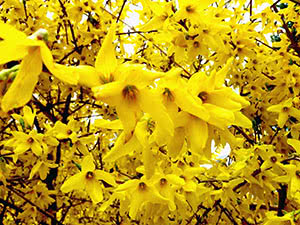 Forsythia plant (lat. Forsythia) is a genus of small trees and bushes of the olive family (Oleaceae), blooming with bright yellow flowers in early spring. The genus of forsythia is very ancient, and this is confirmed by the spread of its natural habitat: six species of forsythia grow in East Asia (Japan, Korea, China), in Europe forsythia flower is represented only by European forsythia (Forsythia europaea) that mainly grows in the Balkans, although you can see forsythia flowering in the middle of March in Germany.
Forsythia plant (lat. Forsythia) is a genus of small trees and bushes of the olive family (Oleaceae), blooming with bright yellow flowers in early spring. The genus of forsythia is very ancient, and this is confirmed by the spread of its natural habitat: six species of forsythia grow in East Asia (Japan, Korea, China), in Europe forsythia flower is represented only by European forsythia (Forsythia europaea) that mainly grows in the Balkans, although you can see forsythia flowering in the middle of March in Germany.
Forsythia flower was named after William Forsyth, a Scottish botanist, a chief gardener of Kensington Palace and one of the founders of the Royal Horticultural Society. It was Forsyth who brought the first forsythia bush to Europe from China.
Forsythia shrub – description
As already mentioned, forsythia is a small tree or shrub with a height of 3.3 to 9.8 ft. The bark has a rough texture and a gray-brown hue. Some species have ternate leaves, but most of forsythias have simple leaves, without stipules, opposite, oval in shape with jagged edges, the length is from 0.8 to 6 inches. Bell-shaped flowers are bright yellow. Flowering of forsythia begins in early spring and lasts up to three weeks, sometimes even longer. And only when forsythia finishes its flowering, the leaves appear on it. Its fruit is a capsule with alate seeds.
Peculiarities of growing of forsythia
Today in Europe it is impossible to imagine urban streets, squares and private gardens without forsythia, and the main reason is that forsythia is the symbol of the spring coming. Gray, winter streets suddenly start blazing with the yellow flame of forsythia flowers, and the citizens, yearning for warmth and greenery, cheer up and begin to prepare for spring. This early flowering of forsythia is a quality that distinguishes it from other shrubs. It is undemanding to care and location that makes it even more popular. What features in care and growing characterize this popular shrub?
- Forsythia is photophilous, but grows in the shade.
- The soil for the plant should be limy.
- Forsythia looks effectively on the background of dark green coniferous plants.
- In autumn, the green leaves of forsythia become golden or purple-violet, and again it attracts attention with its bright, mottled flame.
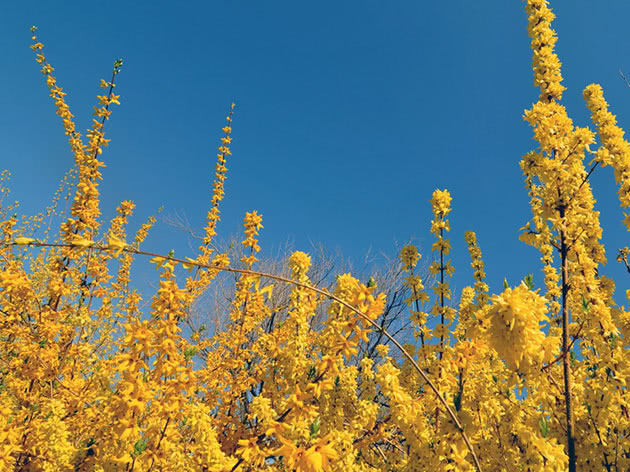
Planting of forsythia
When to plant forsythia
Planting and transplanting of forsythia are carried out in spring or early autumn, before the frost begins, for the plant to have enough time to root before winter. Choose a site protected from the wind. Forsythia tolerates the shade but still loves the light, so the place should be sunny or half-shaded. The composition of the soil is undemanding, but it grows best on slightly alkaline, dry soils. If the pH value is shifted to the acidic side, it is better to dig the soil with wood ash in advance.

How to plant forsythia
Planting holes for forsythia should be 20x20x24 in size, so that the root ball after planting will be at a depth of 12-16 inches. If you plant several bushes, then dig holes at a distance of 5 ft from each other. Before planting, it is necessary to fill the holes with a layer of drainage made of broken bricks or crushed stones 6-8 inches thick, then add 4 inch layer of sand, then a mixture of leaf soil, sand and peat in a ratio of 2: 1: 1 and 7 oz of wood ash. The seedlings of forsythia are placed into a hole, filled with soil and then the soil should be tamped and abundantly watered. If you plant forsythia in spring, then in the future it will require a usual care from you. If forsythia is planted in autumn, care for forsythia will be somewhat more complicated: it will require obligatory mulching of the site, regardless of the variety of plant grown by you. The covering material must be breathable so that in winter during short thaws flower buds will not rot.
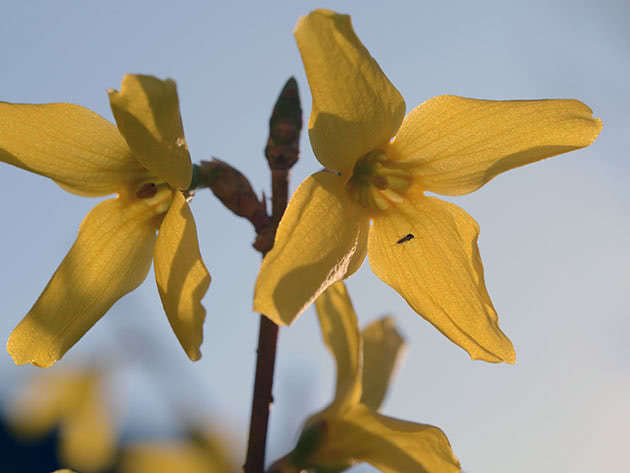
Forsythia – care
How to care for forsythia
Care for forsythia does not differ much from the care for any garden bush. With sufficient amount of precipitation in summer, the plant does not need watering, but if summer is dry, then forsythia should be watered at least once or twice a month at the rate of 2.2-2.7 gallons per each bush. After watering, you need to loosen the soil and remove the weeds, and you need to loosen the soil at the depth of the bayonet for the plant roots to have access to air. After loosening, the place around the stem is mulched with compost or dry soil. Forsythia is fertilized three times a season: in early spring add a fertilizer near the stem, but not close to the branches and stem, add a thick layer of rotted manure, then abundantly water. Manure will be both mulch and organic food for the plant. In April, the soil is filled with a combined mineral fertilizer at the rate of 2-2.5 oz per 11 ft². After flowering, when the plant forms flower buds for the next year, forsythia is fed with a universal fertilizer (3.5-4.2 oz per 11 ft²).

Propagation of forsythia
Propagation is mainly vegetative. For example, forsythia can be propagated by green cuttings about 6 inches long that are better to be cut in June. The lower leaves should be removed, and the cuttings should be pretreated with a rooting hormone (indole-3-acetic acid) and planted in perlite or sand in a greenhouse. You can root lignified cuttings, cut in October, and plant them directly into the soil in the garden, leaving two or three buds above the surface. You just need to cover the cuttings with dry leaves before winter. In spring, when you remove the cover, the rooted cuttings will start growing and by autumn you will get beautiful seedlings. Forsythia can be also propagated by layers: in summer or in autumn bend the lower young shoot to the ground, attach the wire at the base and slightly cut the bark on the side that lies on the ground, fix it, sprinkle with fertile soil, and the shoot will form the roots very soon. In spring cut off this branch from the bush, and the next year the young plant will bloom.

Propagation of forsythia can be carried out in a generative way, that is, by seeds, but this should be done by experts.
Pruning of forsythia
Young forsythia bushes should be pruned for sanitary purposes to remove frozen, dry or broken shoots. If the plant is adult, the frozen tips of the branches should be cut out in spring. The main pruning is carried out in summer, when the flowering ends: the faded branches are shortened by half, the old and dried ones are cut at a height of 1.6-2.4 inches from the soil level, and this will promote the side shoots to grow from the central ones. Pruning also helps regulate the density, height and shape of the bush that can be cup-shaped or spherical. If you need to rejuvenate your mature forsythia, it is better to trim all branches to a height of 1.6-2.4 inches or at least 2/3 to activate the growth of young shoots. But do not overuse these haircuts since it can lead to the active growth of the foliage, but the bush will cease blooming. Forsythia needs pruning once every 3-4 years not to lose its ornamentality.
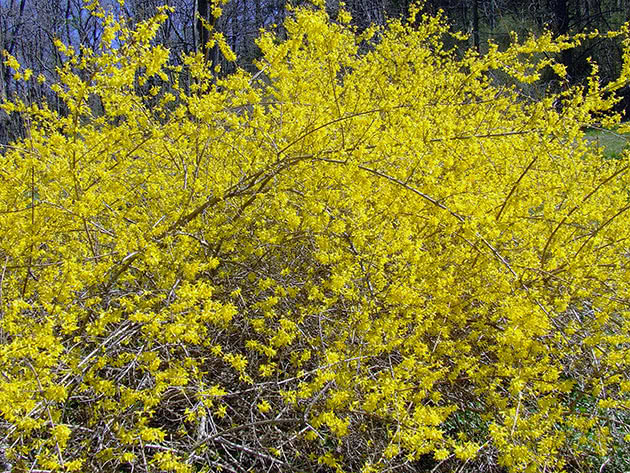
Pests and diseases of forsythia
This shrub is resistant to both pests and diseases, but sometimes it can get affected by wilting, monilia disease and bacteriosis. Wilting is treated by spraying with a fungicide, but there is no treatment of bacteriosis, and the bush will have to be dug out along with the roots and destroyed. Monilia disease manifests itself by brown spots on the leaves. In the case of the disease, you need to cut out and clean all affected places and leave only healthy tissue. There can be some troubles with nematodes. Then it is necessary to disinfect the soil with insecticide.

Forsythia after flowering and fading
To protect forsythia from winter frosts, the area near the stem is covered with a four-inch layer of dry foliage, the branches are bent to the ground and nipped, and the top is covered with spruce branches. In early spring the cover is removed, branches are detached, dry leaves are removed from the trunk. Young plants should be kept covered with spruce branches for the whole winter. Forsythia perfectly tolerates snowy winters even without shelter, but who knows what winter will be like?

Species and varieties of forsythia
The most widespread species of forsythia in our climate zone is European forsythia (Forsythia europaea). It is an erect growing, low, up to 6.5 ft in height shrub with entire oblong leaves up to 2.7 inches long. Its flowers are solitary, bell-shaped, golden-yellow.
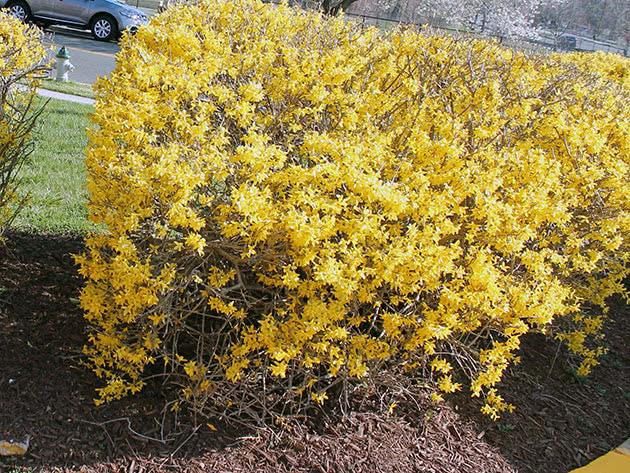
Forsythia giraldiana
is very similar to European forsythia, but it is more sensitive to low temperatures. It is of the same height, its stems are also mostly straight, but tetrahedral, yellow-brown. The leaves are elliptical, dark green, up to 4 inches long. It blooms in May with large elegant light yellow flowers with twisted petals.

Weeping forsythia, or golden-bell forsythia (Forsythia suspensa)
is taller than other species – up to 10 ft in height, with a spreading head, arched, drooping, thin tetrahedral branches of reddish-brown or olive color. The leaves on old shoots are simple, the leaves on leading shoots are triple. The flowers are large, up to 1 inch in diameter, golden yellow, collected in bundles of several pieces. In culture there are several varieties of weeping forsythia:
- forsythia variegata with bright yellow flowers and yellowish variegated leaves
- forsythia fortunei with narrow triple leaves, dark yellow flowers are collected in bundles;
- forsythia artocaulis with dark-red shoots and leaves at the time of opening;
- and others: forsythia Sieboldii, forsythia decipiens.

Greenstem forsythia (Forsythia viridissima)
is a tall, up to 10 ft in height shrub with upward green branches. The leaves are densely growing, simple, oblong-lanceolate, dentate in the upper part, of a very dark green hue, up to 6 inches long, up to 1.5 inches wide. Bright flowers of a greenish-yellow hue are collected in small bundles. It is drought-resistant.
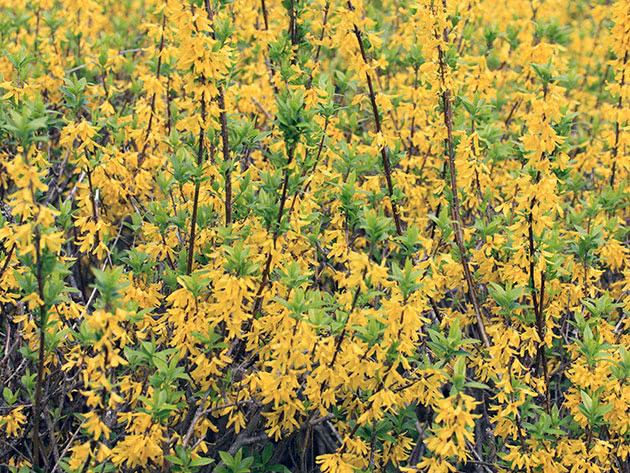
Border forsythia (Forsythia x intermedia)
is a hybrid of weeping forsythia and greenstem forsythia. It grows up to 10 ft in height, blooms in the fourth year of life. Its leaves are oblong with a jagged edge, but there are also triple ones, up to 4 inches long. The leaves remain dark green until late autumn. Bright yellow flowers are collected in bundles of several pieces. It blooms in April-May. It is winter-hardy and drought-resistant. It grows very quickly. The varieties are:
- Beatrix Farrand has the height of 13 ft, the flowers are bright yellow with dark yellow stripes at the base;
- Densiflora is a low bush, up to 5 ft tall, and has the same density, the flowers are pale yellow, twisted. It blooms in May from two to three weeks. It is afraid of frost;
- Spectabilis is one of the most beautiful varieties: the bush is only 3.2 ft high, but the head reaches 4 ft in diameter. The leaves are green in a warm season, in autumn they are purple and bright yellow. The flowers are dark yellow, up to 1.7 inches in diameter. It blooms in late April.
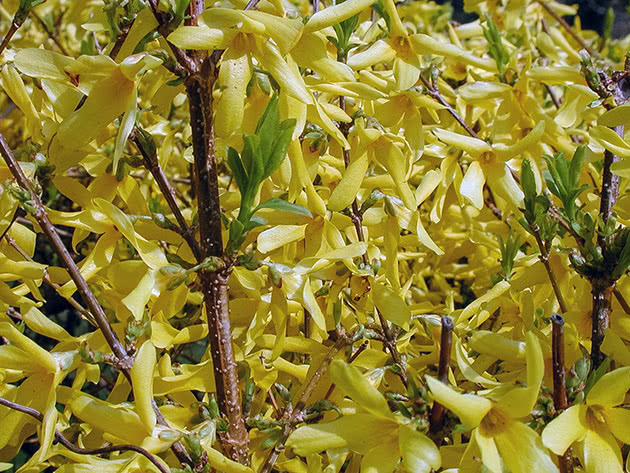
White forsythia (Forsythia abeliophyllum)
reaches a height of 5-6.5 ft. The leaves are oval, up to 3 inches long, in summer the lower side of the leaves has a purple hue. As you can assume from the name, the flowers are white, with yellow throat, the buds are soft pink.

Early forsythia (Forsythia ovata)
is a low shrub, from 5 to 6.5 ft in height. The branches are sprawling, grayish-yellow. The leaves are up to 3 inches long, bright green in summer and purple in autumn. Solitary flowers are bright yellow, up 0.8 inch in diameter. It blooms earlier than all other species of forsythia. It grows quickly. It is winter-hardy and drought-resistant. Popular varieties are:
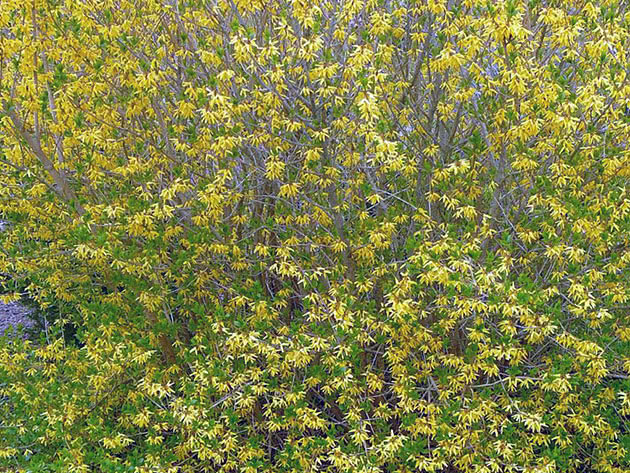
- Spring Glory is up to 10 ft high. The leaves are green in the summer and in autumn they are variegated – from pale yellow to dark purple. It heavily blooms in May with large bright yellow flowers;
- Tetragold is a bush up to 3.2 ft in height, dark yellow flowers are up to 1.2 inches in diameter. It blooms from mid-April;
- Goldzauber is a valuable and very popular variety with large golden yellow flowers. It is frost-resistant. It blooms from mid-April for about three weeks.
